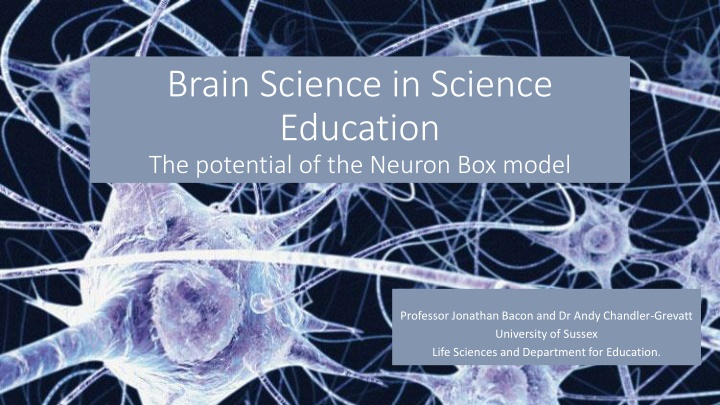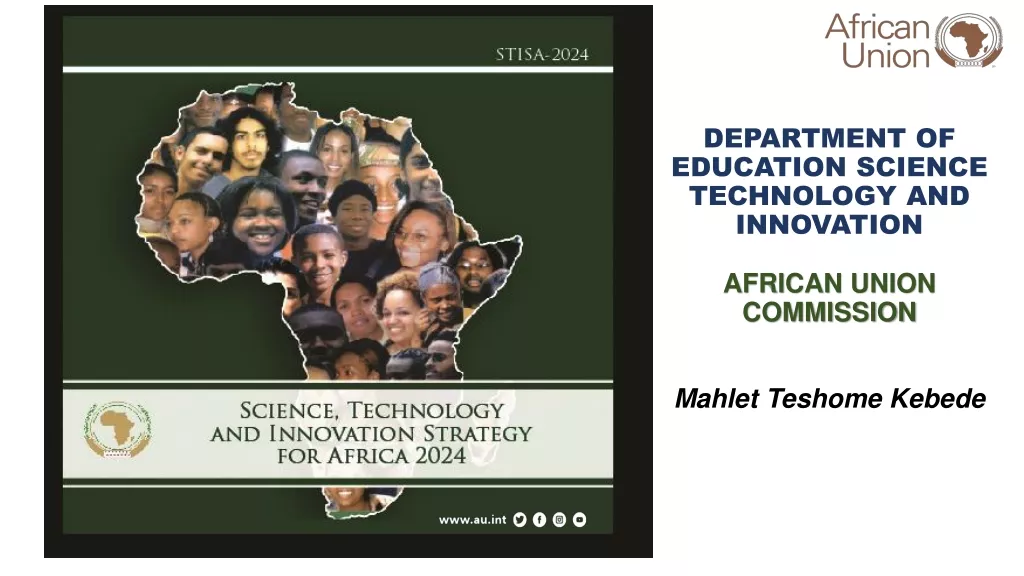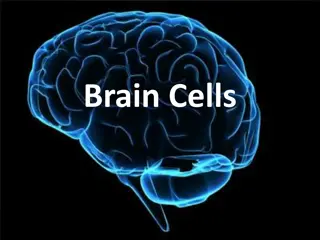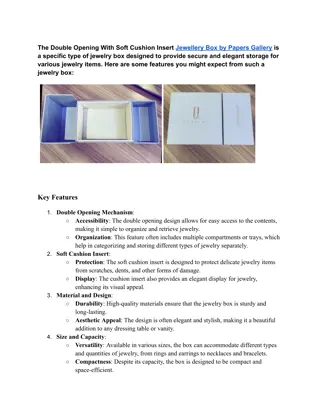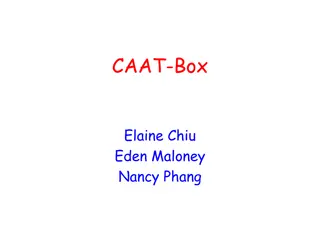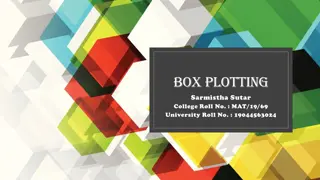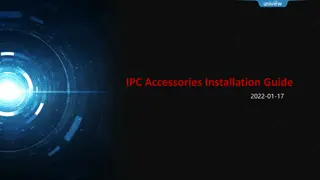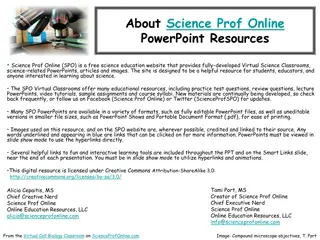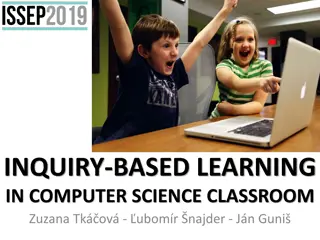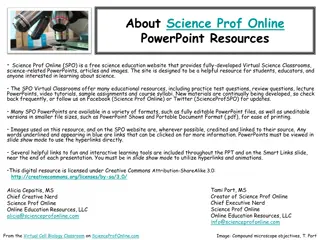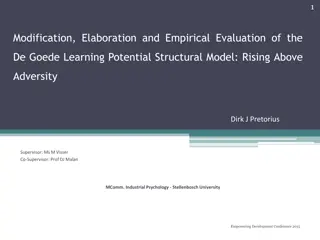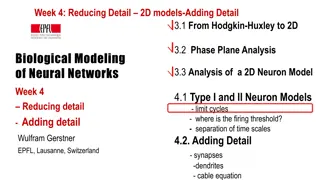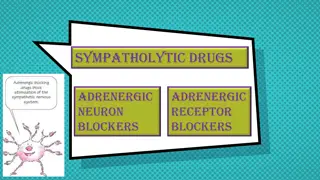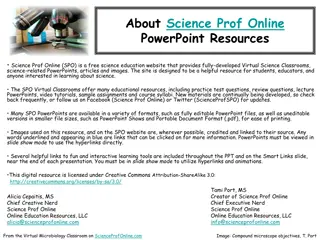Neuron Box Model in Science Education: Potential & Findings
Delve into the Neuron Box model introduced by Professor Jonathan Bacon and Dr. Andy Chandler-Grevatt from the University of Sussex, exploring its impact on learning neurons, brain, and behavior in secondary schools. The model allows students to take on the role of a neuron in an interactive network, presenting insightful findings from a school project and showcasing the collaboration between educators in neuroscience and science education.
Download Presentation

Please find below an Image/Link to download the presentation.
The content on the website is provided AS IS for your information and personal use only. It may not be sold, licensed, or shared on other websites without obtaining consent from the author.If you encounter any issues during the download, it is possible that the publisher has removed the file from their server.
You are allowed to download the files provided on this website for personal or commercial use, subject to the condition that they are used lawfully. All files are the property of their respective owners.
The content on the website is provided AS IS for your information and personal use only. It may not be sold, licensed, or shared on other websites without obtaining consent from the author.
E N D
Presentation Transcript
Brain Science in Science Education The potential of the Neuron Box model Professor Jonathan Bacon and Dr Andy Chandler-Grevatt University of Sussex Life Sciences and Department for Education.
T16 BERG: Brain Science in Schools T16 BERG: Brain Science in Schools 1100-1200 Muirhead 109 Teaching models that support learning of neurons, brain and behaviour for secondary schools are scarce. We used the Neuron Box in which each pupil in a class assumes the role of a neuron by operating their own neuron within an interacting network. We present the findings from a school. Andrew Chandler-Grevatt & Jonathan Bacon - University of Sussex
Contents Contents Introducing the project Introducing the neuron boxes The evaluation project A case for neuroscience in school Pilot findings Project interim findings Next steps and implications
Collaboration Collaboration Professor Jonathan Bacon Professor of Neuroscience Head of the School of Life Sciences Dr Andy Chandler-Grevatt Teaching Fellow in Science Education Department of Education, University Sussex. Dr Jonathan Hare Richard Robinson
Where it began Where it began
The Neuron Box The Neuron Box B C A Fig. 1 A. Neuron circuit symbol: this has two excitatory inputs (left), one inhibitory input (bottom) and one output (axon) on the right. In the circuit each neuron is labelled with a number and a letter representing where it is in the neural circuit (see text). B, C. Neurons in action. The Neuron Box has excitatory (red plug) and inhibitory (black plug) inputs connected. B Pressing the button when an excitatory input is active (green light just gone ON). C About to let go of the button when an inhibitory signal is active (red light ON). ! !
Neuron Boxes in Action Neuron Boxes in Action Video will be embedded here
Research Questions Research Questions Does it have any impact (affective or cognitive)? Is there need for this intervention? So what? How does pupils knowledge and understanding of neurones, brain and behaviour change during Year 10? What effect does the use of Neurone Boxes as a teaching model on conceptual development and attitudes towards (neuro)science?
Importance of Neuroscience Importance of Neuroscience Scientific Interest Political interest Media interest Rise of fMRI (functional magnetic resonance imaging) (Logothetis, 2008) Promise of medical advances (Charney et al., 2013) neuromyths (OECD, 2002a, Pasquinelli, 2012). BRAIN initiative (Brain Research through Advancing Innovative Neurotechnologies) Proliferation of neuroscience research (Lieberman, 2007; Becker & Cropanzano, 2010) (Obama, 2013)
Childrens understanding of the neurons Children s understanding of the neurons Relatively under researched Children s mental models In Society (Pasquinelli, 2012) (Bartoszeck & Bartoszeck, 2012 p. 133) Age 14 Neuromyths (Johnson & Wellman, 1982; Gottfried et al. 1999) Of About education teachers (Dekker et al, 2012) (e.g. Adey and Dillon, 2012)
National Curriculum (England) National Curriculum (England) Key Stage 3 (11-14 year olds) does not include the nervous system (Department for Education, 2013a). Key Stage 4 (14-16 year olds) that pupils are expected to study the brain and the central nervous system (Department for Education, 2013b): GCSE biology specifications should require students to describe the structure and function of the brain [and] explain some of the difficulties of investigating brain function. (Department for Education 2013b, p.13). These were elaborated as reflex arcs, synapses and the structure of the brain by most examination boards (e.g. AQA, 2014).
Current Teaching Modes and Models Current Teaching Modes and Models Reaction times and touch-sensitivity of the skin (Cassidy, 2011 p.124). Labelled diagrams (Williams, 1996 p. 122) Three-dimensional models of the brain. Kohn (1993) describes an allegory of college life to help undergraduates learn, and remember, the principles of neural conduction Marchioni (1995): dissection of chicken brains, drawing a sensory homunculus from their own experimental data, a role-play demonstration of a nerve impulse to calculate its speed. Griff (2006) describes using the analogy of a sparkler to demonstrate an action potential and a frying pan to model synaptic function.
Models and Modelling Models and Modelling Gilbert & Boulter (1998 p. 54) define what a model is, [A] simplified representation of a system, which concentrates attention on specific aspects of the system. Moreover, models enable aspects of the system, i.e., objects, events, or ideas which are either complex, or on a different scale to that which is normally perceived, or abstract to be rendered either visible or more readily visible. Gobert & Buckley (2000 p. 1012) define what models do, Analogical models comprise the scaled and exaggerated objects; symbols, equations and graphs; diagrams and maps; and simulations that facilitate scientific communication. They can be concrete, abstract or theoretical depending on the needs of their author and audience, but above all models must enhance investigation, understanding and communication and this makes them key tools in thinking and working scientifically.
Pilot of the Evaluation Tool Pilot of the Evaluation Tool 3 schools: Year 9 [~ 50 responses] and Year 10 [76 responses] Two versions of questionnaires qualitative questions. Explain how your leg pulls up quickly if you step on a drawing pin. Explain how your eyes blink if a stone flies up towards your face. Explain how we keep breathing when we are asleep. Explain how we keep walking without thinking about it. Explain how memories form. Explain how we remember something. Questions to teachers about administration Conclusions Target Group: Year 9 responses are very limited, so Year 10 is the appropriate year group to study. Administration of Questionnaire: 20 minutes maximum Decides upon written questions (underlined above. Initial Rubric trialled.
Initial Rubric Initial Rubric Rubric Score 0 Description Notes Number of responses 5 2 Nothing drawn or written. Incorrect or irrelevant to question. Uncategorisable. Some senses identified (drawn or labelled). Some relevant organs drawn or labelled. 1 19 2 Unconnected brain, spinal cord or nerves drawn or labelled. Simple system recognised showing connections between brain, spinal cord and/or nerves. 17 3 These may be correct or incorrect. A variety of models were identified here. This section could have sub-categories. Students recognise that there are connections between the key organs, but may not appreciate exactly how they are connected. 28 4 Complex system recognised showing mostly correct connections between brain, spinal cord and/or nerves. Differentiation between types of neurons (motor and sensory) Detailed response within the complex system, with a focus on a reflex arc or synapse. May include key words associated with the reflex arc or synapse, but not necessary correct. 5 5
Emerging Misconceptions from Drawings Emerging Misconceptions from Drawings Alternative models provided by students Brain, spinal cord, sense organs and nerves are unconnected Neurones start at top of spinal cord and radiate to rest of body The diffuse or unstructured model of nerves in the body Misconceptions identified Nerves and veins being used interchangeably or conflated. Vertebrae and nerves being used interchangeably or conflated. Heart as part of the nervous system. Nerves and hormones conflated See Handout for examples
Main Study Methodology Main Study Methodology Probe Probe Probe 6 months 6 weeks 2 1 3 * B Three intervention classes: top, middle, bottom sets. A Six control classes: top, middle, bottom sets. B One school A. Intervention before any nerves taught: JB & ACG ran three similar 1 hour lessons using Neuron Boxes. B. Normal teaching of Nerves Topic * Student evaluation of intervention session
Analysis Analysis Based on Reiss and Tunicliffe (2001) Phase 1: Collect data from classes Phase 2: Jointly and repeatedly sort. Rank on scientific understanding. Phase 3: Decide on scoring system for aspects of each answer. Make rubric(s). Phase 4: Independently and separately score each response. Into Excel spreadsheets. Phase 5: Compare agreement (as percentage). Discuss differences. Phase 6: Analyse data.
Session Evaluation by Students Session Evaluation by Students Neither agree or disagree Strongly Agree Strongly Disagree Agree Disagree Question Total 1. I enjoyed this session 20 41 5 6 2 74 2. I found this session interesting 21 37 7 9 0 74 3. I learnt something new in the session. 35 34 3 2 0 74 4. It made me think about being a scientist. 2 12 29 20 10 73 5. It made me think about doing A-level biology 4 6 30 24 10 74 6. It made me think about becoming a neuroscientist. 1 5 27 24 17 74 7. I would recommend this session to other Year 10 classes. 18 36 15 2 3 74
Session Evaluation by Students (Qualitative) Session Evaluation by Students (Qualitative) Write down or draw three things that you have learnt in the session Headlines from first rough analysis (note pupils were asked to write three points) 41% used the word neuron (various spellings) 38% quoted that the brain contains billions on neurons (variations to be analysed) 30% mentioned the shape of the brain is related to size/surface area (accuracy to be analysed) 12% mentioned that the number of neurons decreases with age 9% mentioned that neurons worked using simple rules. 7% mentioned that we use all of our brain/not 10% 7% attempted to draw a neuron from memory 5% mentioned there is a gap/synapse between neurones (accuracy needs further analysis) 4% mentioned a reflex arc.
Next steps. Next steps. Administer Probe 2 in January 2016 Administer Probe 3 in June 2016 Analyse Probe 1 data and refine rubric, % comparison Analyse Probe 2 data, % comparison Analyse Probe 3 data, % comparison Compare intervention and control groups changes in diagrams over time. Analyse one off data from other cohorts (Undergrads, Science ITE, Primary ITE)
Implications Implications In the school Increased awareness of neuroscience in control group. Feedback to science teachers to improve teaching and learning of the nerve topics. Neurone Box Outreach Evaluation of using the boxes to inform future sessions. Improvements to evaluation of sessions. Adaptations to Neuron Boxes for regular classroom use. Science Education Research Under researched, so adds to a field of knowledge. Identification and challenging of misconceptions of nervous system. Identification of possible progress pathways and pinch points. Policy in Science Education When and how to teach about neuroscience. Inform STEM agenda and outreach programmes.
References References Adey, P., & Dillon, J. (2012). Bad Education: Debunking Myths in Education. London: McGraw-Hill International. AQA (2014) GCSE Biology Specification B1.3 the use and abuse of drugs http://www.aqa.org.uk/subjects/science/gcse/biology-4401/subject-content [accessed 4/11/2014] Bartoszeck, A., & Bartoszeck, F. (2012). Investigating children's conceptions of the brain: First steps. International Journal of Environmental & Science Education, 7(1), 123-139. Becker, W. J., & Cropanzano, R. (2010). Organizational neuroscience: The promise and prospects of an emerging discipline. Journal of Organizational Behavior, 31(7), 1055-1059. Cassidy, M. (2011) Communication and Control Chapter 5 in Reiss, M. (Ed) (2011) Teaching Secondary Biology. Second Edition. London: Hodder Education. Charney, D. S., Nestler, E. J., Sklar, P., & Buxbaum, J. D. (Eds.). (2013). Neurobiology of mental illness. Oxford: Oxford University Press. Department for Education, (2013a) Science programmes of study: key stages 1 and 2 National curriculum in England. DFE-00182-2013. London: DfE. Department for Education, (2013b) Science programmes of study: key stages 3 and 4 National curriculum in England. DFE-00185-2013. London: DfE. Dekker, S., Lee, N. C., Howard-Jones, P. & Jolles, J. (2012). Neuromyths in education: Prevalence and predictors of misconceptions among teachers. Frontiers in psychology, 3, 1-4. Driver, R., Squires, A., Rushworth, P. & Wood-Robinson, V. (1993). Making Sense of Secondary Science: Research into Children s Ideas. Taylor & Francis. Retrieved 13 April 2014, from <http://www.myilibrary.com?ID=30909> Gathers, A. (2008). Using a passing game to teach nerve conduction. The American Biology Teacher, 70(1), 11-11. Gilbert, J. K. (2004). Models and modelling: Routes to more authentic science education. International Journal of Science and Mathematics Education, 2(2), 115-130. Gilbert, J.K. & Boulter, C. (1998). Learning science through models and modelling. In B. Fraser & K. Tobin (Eds.), International handbook of science education, 2, 53 66. Dordrecht: Kluwer Academic Publishers. Gobert, J. D. & Buckley, B. C. (2000). Introduction to model-based teaching and learning in science education. International Journal of Science Education, 22(9), 891-894. Goswami, U. (2006). Neuroscience and education: from research to practice? Nature Reviews Neuroscience, 7(5), 406-413. Gottfried, G. M., Gelman, S. A. & Schultz, J. (1999). Children's understanding of the brain: From early essentialism to biological theory. Cognitive Development, 14(1), 147-174.
References continued References continued Griff, E. R. (2006). How Neurons Work: An Analogy & Demonstration Using a Sparkler & a Frying Pan. The American Biology Teacher, 68(7), 412-417. Hay, D. B., Williams, D., Stahl, D. & Wingate, R. J. (2013). Using drawings of the brain cell to exhibit expertise in neuroscience: Exploring the boundaries of experimental culture. Science Education, 97(3), 468-491. Johnson, C. N. & Wellman, H. M. (1982). Children's developing conceptions of the mind and brain. Child development, 222-234. Kohn, A. (1993). Neural communication in a mnemonic nutshell: A cognitive framework that improves understanding. American Biology Teacher, 55, 21-21. Lieberman, M. D. (2007). Social cognitive neuroscience: a review of core processes. Annu. Rev. Psychol., 58, 259-289. Logothetis, N. K. (2008). What we can do and what we cannot do with fMRI. Nature, 453(7197), 869-878. Marchioni, W. (1995). The Brain: User-Friendly & a Fascinating Classroom Subject. The American Biology Teacher, 365-369. Obama, B. (2013). http://www.whitehouse.gov/share/brain-initiative [accessed 26 May 2014) OECD (2002a). Understanding the Brain: The Birth of a Learning Science. Paris: OECD. OECD (2002b). Dispelling "Neuromyths in OECD, Understanding the Brain: The Birth of a Learning Science, Paris: OECD. Pasquinelli, E. (2012). Neuromyths: why do they exist and persist? Mind, Brain, and Education, 6(2), 89-96. Reiss, M. J., & Tunnicliffe, S. D. (2001). Students' understandings of human organs and organ systems. Research in Science Education, 31(3), 383-399. Weisberg, D. S., Keil, F. C., Goodstein, J., Rawson, E. & Gray, J. R. (2008). The seductive allure of neuroscience explanations. Journal of cognitive neuroscience, 20(3), 470-477. Williams, G. (1996) Biology for You. National Curriculum Edition for GCSE. Cheltenham: Stanley Thornes.
Contact Contact Professor Jonathan Bacon J.P.Bacon@sussex.ac.uk Dr Andy Chandler-Grevatt A.J.Grevatt@sussex.ac.uk
